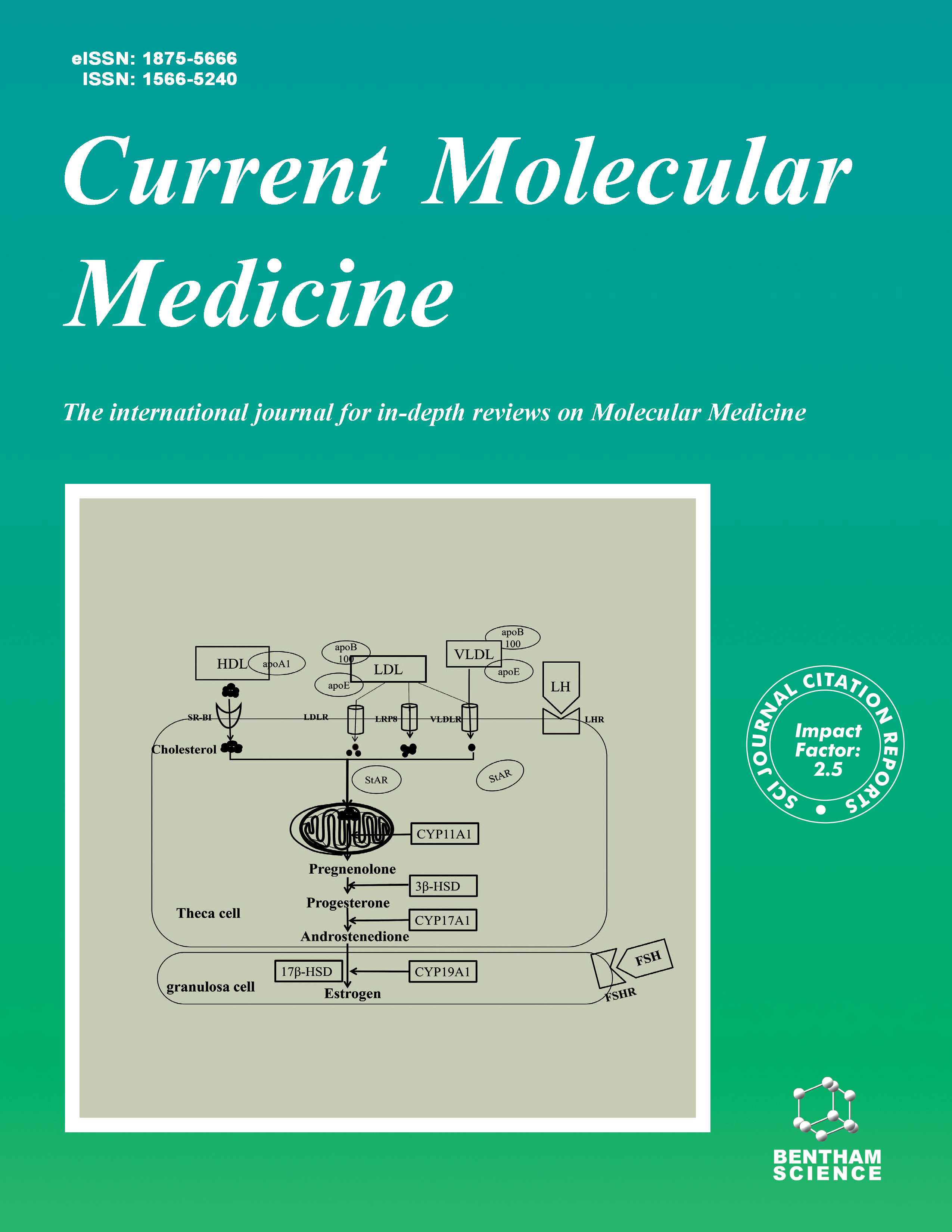- Home
- A-Z Publications
- Current Molecular Medicine
- Issue Home
Current Molecular Medicine - Current Issue
Volume 25, Issue 3, 2025
-
-
The Emerging Role of LncRNA AWPPH in Multiple Cancers: A Review Study
More LessLong non-coding RNAs (lncRNAs) are transcribed RNA molecules longer than 200 nucleotides in length that have no protein-coding potential. They are able to react with DNA, RNA, and protein. Hence they involve in regulating gene expression at the epigenetic, transcriptional, post-transcriptional, and translational levels. LncRNAs have been proven to play an important role in human malignancies and prognostic out Read More
-
-
-
Metabolic Derangement in Non-Alcoholic Fatty Liver Disease: Opportunities for Early Diagnostic and Prognostic Markers
More LessNon-alcoholic fatty liver disease is a globally prevalent disorder that can rapidly progress if not detected early. Currently, no accepted markers exist for early diagnosis and prognosis of NAFLD. This review describes derangement in major metabolic pathways of lipid, carbohydrate, and amino acids in NAFLD. It suggests that measuring levels of thrombospondin, TyG index, asymmetric dimethylarginine, LAL-A, GLP-1, FGF-21, an Read More
-
-
-
The Potential Therapeutic Applications of CRISPR/Cas9 in the Treatment of Gastrointestinal Cancers
More LessGastrointestinal (GI) cancer is one the most prevalent types of cancer. Despite current chemotherapy's success, patients with GI cancer continue to have a dismal outcome. The onset and progression of cancer are caused by alterations and the abnormal expression of several families of genes, like tumor-suppressor genes, oncogenes, and chemotherapy-resistant genes. The final purpose of tumor therapy is to inhibit cellular dev Read More
-
- Life Sciences, Biochemistry, Medicine, Research & Experimental, Biochemistry And Molecular Biology, Molecular Medicine
-
-
-
Current Perspectives on Attention-deficit Hyperactivity Disorder
More LessAuthors: Shaik Shafiullah and Suneela DhaneshwarAttention-deficit hyperactivity disorder (ADHD) is a neurobiological and neurodevelopmental disorder with an idiosyncratic genetic base. ADHD presents various characteristics, such as inattention, hyperactivity, and impulsivity. Over the period, ADHD leads to noticeable functional disability. A five- to ten-fold progressed risk of disorder development is observed in the populations with familial history of ADHD. Th Read More
-
-
-
-
Implication of Thioredoxin 1 and Glutaredoxin 1 in H2O2-induced Phosphorylation of JNK and p38 MAP Kinases
More LessBackground Aerobic organisms continuously generate small amounts of Reactive Oxygen Species (ROS), which are involved in the oxidation of sensitive cysteine residues in proteins, leading to the formation of disulfide bonds. Thioredoxin (Trx1) and Glutaredoxin (Grx1) represent key antioxidant enzymes reducing disulfide bonds. Objective In this work, we have focused on the possible protective effect of Trx1 and Grx1 Read More
-
-
-
Exosomes Derived from Astragaloside IV-pretreated Endothelial Progenitor Cells (AS-IV-Exos) Alleviated Endothelial Oxidative Stress and Dysfunction via the miR-210/ Nox2/ROS Pathway
More LessAuthors: Wu Xiong, Xi Zhang, Xiao-Ling Zou, Sai Peng, Hua-Juan Lei, Xiang-Nan Liu, Lan Zhao and Zi-Xin HuangBackground Chronic hyperglycemia in diabetes induces oxidative stress, leading to damage to the vascular system. In this study, we aimed to evaluate the effects and mechanisms of AS-IV-Exos in alleviating endothelial oxidative stress and dysfunction caused by high glucose (HG). Methods Histopathological changes were observed using HE staining, and CD31 expression was assessed through immunohistochemistry (IHC). C Read More
-
-
-
Explore on the Mechanism of miRNA-146a/TAB1 in the Regulation of Cellular Apoptosis and Inflammation in Ulcerative Colitis Based on NF-κB Pathway
More LessAuthors: Xiaoying Xia, Qian Yang, Xue Han, Yulin Du, Shujun Guo, Mengqing Hua, Fang Fang, Zhigang Ma, Hua Ma, Hui Yuan, Wenjing Tian, Zebang Ding, Yanan Duan, Qi Huo and Yao LiObjective Ulcerative colitis (UC) is a chronic non-specific inflammatory disease of the rectum and colon with unknown etiology. A growing number of evidence suggest that the pathogenesis of UC is related to excessive apoptosis and production of inflammatory cytokines. However, the functions and molecular mechanisms associated with UC remain unclear. Materials and Methods The in vivo and in vitro models of UC were establ Read More
-
-
-
Study on the Mechanism of Notch Pathway Mediates the Role of Lenvatinib-resistant Hepatocellular Carcinoma Based on Organoids
More LessAuthors: Weiqing Feng, Haixiong Zhang, Qing Yu, Hao Yin, Xiaowei Ou, Jie Yuan and Liang PengBackground The emergence of treatment resistance has hindered the efficacy of targeted therapies used to treat patients with hepatocellular carcinoma (HCC). Objective This study aimed to explore the mechanism of organoids constructed from lenvatinib-resistant HCC cells. Methods Hep3B cell and human HCC organoids were cultured and identified using hematoxylin and eosin staining and Immunohistochemistry. Le Read More
-
-
-
LKB1 Mutations Enhance Radiosensitivity in Non-Small Cell Lung Cancer Cells by Inducing G2/M Cell Cycle Phase Arrest
More LessAuthors: Yuanhu Yao, Xiangnan Qiu, Meng Chen, Zhaohui Qin, Xinjun Zhang and Wei ZhangBackground Radiosensitivity remains an important factor affecting the clinical outcome of radiotherapy for non-small cell lung cancer (NSCLC). Liver kinase B1 (LKB1) as a tumor suppressor, is one of the most commonly mutated genes in NSCLC. However, the role of LKB1 on radiosensitivity and the possible mechanism have not been elucidated in the NSCLC. In this study, we investigated the regulatory function of LKB1 in the Read More
-
Volumes & issues
-
Volume 25 (2025)
-
Volume 24 (2024)
-
Volume 23 (2023)
-
Volume 22 (2022)
-
Volume 21 (2021)
-
Volume 20 (2020)
-
Volume 19 (2019)
-
Volume 18 (2018)
-
Volume 17 (2017)
-
Volume 16 (2016)
-
Volume 15 (2015)
-
Volume 14 (2014)
-
Volume 13 (2013)
-
Volume 12 (2012)
-
Volume 11 (2011)
-
Volume 10 (2010)
-
Volume 9 (2009)
-
Volume 8 (2008)
-
Volume 7 (2007)
-
Volume 6 (2006)
-
Volume 5 (2005)
-
Volume 4 (2004)
-
Volume 3 (2003)
-
Volume 2 (2002)
-
Volume 1 (2001)
Most Read This Month Most Read RSS feed
Article
content/journals/cmm
Journal
10
5
false
en


